That’s last year’s record for a long-delayed show report broken!
This year’s Wakefield Show took place on 21st April, at the Cedar Court Hotel, organised by the local user group – the Wakefield RISC OS Computer Club (WROCC).
Like last year, I must apologise for another long-delayed RISCOSitory show report. As ever, this is mainly because of how busy I am outside the world of RISC OS, but also because I wanted to edit down my video recordings of the theatre talks to a more manageable length – and video editing can take a lot of time.
Having not been able to find enough large blocks of spare time for that task, I’ve now decided to give up on it for now, and proceed to write the show report without the edited videos. Thankfully, WROCC’s Ruth Gunstone also recorded the talks, and has uploaded them to Youtube, so I will simply refer to and embed those in this report.
The show pictures this year were taken with a camera kindly loaned to me for the show by Ron Briscoe because (in another repeat of last year), I discovered on the day that I didn’t have my own camera with me. At least, I thought I didn’t – but when I returned home the following day, I couldn’t find my camera there. In the end I did find it – in the car, buried under some other bits and pieces . I had it with me the whole time, but just couldn’t see it. Ho hum.
So with my excuses and (and silly mistakes) out of the way, let’s get on to the report itself!
The show took place in the usual set of rooms in the hotel, the Cypress Suite, and Hawthorne and Oak Suites. I shall refer to the Cypress Suite as the RISC OS Room, since it was where most of the RISC OS exhibitors were based, and the Hawthorne and Oak Suites as the Retro Room, because that’s where the Retro exhibitors were based – although it seems there were fewer of them this year, with some RISC OS exhibitors also occupying the room.
The report will therefore follow the now customary figure-8 path, working anti-clockwise around the Retro Room, then clockwise around the RISC OS Room.

Wakefield RISC OS Computer Club
After paying your entry fee, the first exhibitor was the user group that organises the event – the Wakefield RISC OS Computer Club (WROCC).

A very well and formally run club, they were obviously aiming to persuade visitors of the benefits of membership, which includes a newsletter delivered by email, access to a group mailing list, and so on. A key benefit, for members who are either local or who happen to be in the area at the time, is free entry into meetings (versus a £3.00 entry fee for non-members).

These meetings are held monthly, and there is often either a guest speaker, bringing along their latest products or developments, or someone from within the group talking on a topical subject.
Other goodies available from the WROCC stand included a CD containing all the back issues of their newsletter – and, exclusively for me, a complaint by Chris and Steve Bass, who were manning the stand, that they’d initially believed this year’s April Fool post (for which the real credit belongs to Rick Murray) until someone pointed out the date to them.
Well, I say “complaint” – in reality, I think I was told off!
Oops. Sorry, guys! I really am, and I definitely didn’t leave your stand with a grin on my face as a result, oh no. I feel genuine regret about the whole thing – well, when I say the whole thing, what I mainly regret is forgetting to email Rick after the show to tell him someone fell for it. I’ll point it out to him when I publish this report.
There was also a prize draw being run on the stand, for which Sine Nomine Software’s Hilary Phillips drew the winning tickets towards the end of the show. The first prize went to Chris Pennington, who won a Raspberry Pi 3+ and an Ident Case, and the runner up prize of a £15.00 Amazon gift voucher went to Timothy Baldwin.
Charity stand
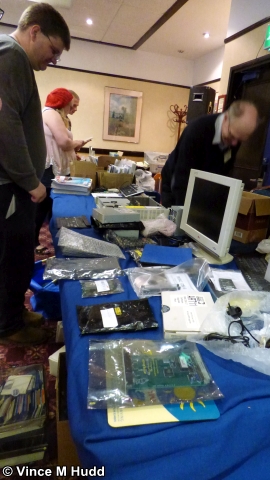
The next stand was where, in return for a contribution to a worthy cause, you might have been able to pick up that old piece of software you’ve always wanted, or that missing magazine to complete your collection, and so on.
Apparently, the stand did brisk business this year, with almost nothing remaining at the end of the day, and a cheque for £1,051.53 was presented to a representative of the Wakefield Hospice at the September WROCC meeting. An impressive amount of money, so congratulations to all involved – including anyone who donated goods to be sold, or who purchased anything from the stand on the day.
Retro Acorn
The next exhibitor I have listed belonged, apparently, to Retro Acorn – but I don’t seem to have noted any real details or taken any pictures specifically of this stand (or that I can definitely say are of this stand). My recollection is that it consisted of a number of 8-bit computers, all running games.
I admit that I generally have much less interest in the retro/8-bit scene than RISC OS, but I usually have something more than a vague memory – so apologies to whoever had this stand!
Rob Coleman
The 8-bit computers from Acorn had a considerably more limited range of colours available for use than modern hardware, with a maximum of 8 different colours (and flashing combinations), assignable to a logical selection of 16 palette entries in the lowest resolution screen modes.
Rob Coleman has developed an upgrade for the BBC Microcomputer that gets around that limitation to some extent. As I understand it, while the number of colours available for use in any given screen mode remains, Video NuLA makes a palette of 4,096 colours available to the system. MODE 2, for example, offers a logical palette of sixteen colours, which are by default set up as the basic eight colours, and eight flashing combinations. With Video nULA installed, those sixteen logical colours can be set to any of the 4,096 it makes available.
In addition to the much greater range of available colours, the upgrade also provides hardware support to provide smooth horizontal scrolling.
Daniel Jameson
Long time followers and users of the Acorn platform will be aware of the BBC Domesday Project, from 1986. Inspired by the original Domesday Book from 1086, the modern version saw a large amount of data collected in digital form and put on LaserDisc, with a hardware system based around a BBC Master to access the material.
Daniel Jameson had a Domesday emulation of sorts set up on his stand, benefiting from more up to date technology. Rather than accessing original LaserDiscs, he had a BBC Master set up with BeebSCSI, a SCSI storage emulation that uses modern solid state storage – specifically, micro-SD cards – for storage.
The original discs used by the BBC Domesday Project held about 650 megabytes each, and there were two of them – a seemingly vast amount of data at the time, but almost nothing by today’s standards.
Retro Hardware
The Acorn Electron was the focus of attention on the Retro Hardware stand, with a range of upgrades being shown off for it.

Some of these were new versions of old products from P.R.E.S., such as the Advanced ROM Adaptor. This was an early upgrade available from the company, to allow the use of up to two EPROMs with the computer, and the version available from Retro Hardware is little changed from the original design.
There were also newer items, as well, such as the Advanced Plus 6, an expansion board for the Electron that fits inside the old Plus 1, and allows for additional RAM or EPROMs to be installed.

By far the most interesting for me was the Mega Games Cartridge. Plugged into the computer via the Plus 1 expansion, the cartridge includes a 32 megabit (i.e four megabyte) FlashRAM, which is presented to the host computer as 256 pages of 16KB – all but two of which can be pre-programmed with a game (the other two blocks are for the index and menu system).
The initial selection of games is chosen by the user when purchasing the cartridge, but with provided utilities, the content can be reprogrammed by the user.
As most readers of this show report will know, back in the early 1980s, the BBC Microcomputer was the machine most likely to be found in schools in the UK, not just for learning about computers, but also as a support tool for other subjects, with a wide range of software for use on it in that context.
Flax Cottage Educational Archive
John Dale operates the Flax Cottage Educational Archive, and he was on the next stand, exhibiting some of his huge archive of educational software for Acorn computers – some of it running on something a little more modern: ELKPi, a Raspberry Pi housed in an Acorn Electron case.
Midlands user Group
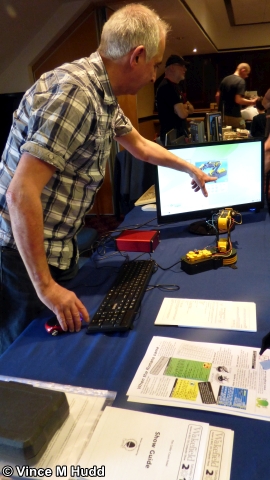
This year, the Midlands User Group (MUG) had their own stand at the show.
The group currently meets on the third Saturday afternoon of every other month in Bromsgrove, and those meetings often include either a guest speaker discussing their latest piece of software or hardware, or one of the members giving a talk on a topical or relevant subject.
And when it’s neither of those, the meeting tends to take the form of a ‘hands on workshop’, enabling members to share their knowledge and expertise with others, to help solve their hardware and software problems.
However, the members manning the stand weren’t just chanting “join us” to anyone willing to listen, but also showing off a robot arm.
Impression-X
Richard Keefe was on the next stand, where he reported that he had fixed some colour issues in Impression-X (website still MIA), and was finalising a new release for those who were currently subscribed to receive new versions of the software, which he is in the process of updating to 32-bit.
If I’ve remembered this correctly, the last release before Wakefield was in late 2017 – possibly around the time of that year’s London Show.
Richard’s policy is that a £60 subscription buys you the current version and three updates. A significant feature of the update that was being readied at the time is greatly improved handling of JPEGs, via a new version of the JPEG loader, TransJPEG.

MW Software
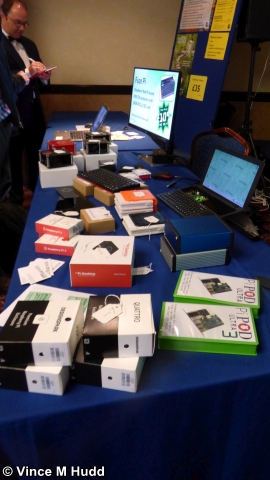
Richard’s stand was the last of those in the Retro Room, so heading into the RISC OS Room and switching to the other side and direction, the first exhibitor was Martin Würthner on the MW Software stand.
Martin had an updated version of the ArtWorks viewer on show. This is a separate and free program to ArtWorks that allows anyone with a RISC OS computer to view ArtWorks files, and even use them in other applications, such as the aforementioned Impression-X.
The new version of the application makes good use of some of the newer features that Martin has added to ArtWorks2 itself, such as the multi-page facility. The AWViewer now sports a ‘full screen mode’ which, in conjunction with a multi-page ArtWorks file, could potentially be used as way to show presentations.
Like some other packages, the software also had to be updated to handle the new “LTRGB” screen modes correctly, as used on the IGEPv5 and Titanium boards.
Martin was also selling the latest versions of ArtWorks2 itself and Easi/TechWriter – although there were no new versions released to coincide with the show.
RISCOSbits
Moving on from Martin’s usual snazzy attire to some snazzy looking cases, Andy Marks was showing off his wares on the RISCOSbits stand.

Shortly before the show, a joint announcement was made by RISCOSbits and Ident Computer to say that RISCOSbits had become an authorised reseller of Ident’s RISC OS products, with Ident themselves stepping back from the market. This was in recognition that there was some overlap in some of their products, and that the RISC OS market would be better served with cooperation rather than competition between them.
The first joint product resulting from that, was available at the show: The Wispy CE – an Ident twin-slice RISC CE benefiting from RISCOSbits’ Wispy in the second slice to provide wireless connectivity, and other Linux resources to the Raspberry Pi running in the first slice.

Of course, Andy also had his various other products available as well, such as the variously coloured extruded gas aluminium BÜRP – which was named as the result of a poll run last year. That name, it seems, has since become a backronym, and now stands for “Board – Universal Receptacle Package.”
Apparently, Andy also had a FUZE Pi available on the day; a Raspberry Pi housed in a FUZE case – an Acorn Electron-style wedge shaped case, not dissimilar to the Micro One from Ident but made of metal rather than plastic, and featuring FUZE BASIC running on a custom Linux image for the Pi.
North One Communications (Organizer)
Users needing to get themselves organised were catered for next, with the premier filofax offering for RISC OS.
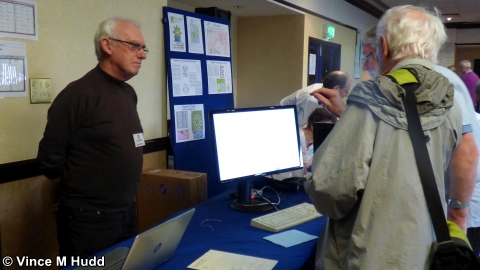
Version 2.28a of the – no, THE – personal information manager for RISC OS, Organizer, was available to purchase from North One Communications, both as a software package in its own right, or as the ‘on-a-stick’ edition, supplied on a USB flash drive, ready to run in a copy of RPCEmu.
Representing a small upgrade to version 2.28, released at the 2018 London Show, the ‘a’ suffix brought a mixture of enhancements and bug fixes, including improvements to the way it communicates with Sine Nomine’s RiscOSM. Speaking of which…
Sine Nomine
Both Matthew and Hilary Phillips of Sine Nomine Software were present at Wakefield, showing off the latest versions of RiscOSM, Impact, and their other products.

RiscOSM has, in recent versions, gained contour lines – not just for the UK through Ordnance Survey data, but also much of Western Europe thanks to data from NASA’s Shuttle RADAR Topography Mission. Much closer to the Wakefield Show, the software gained the ability to use this data to show a gradient profile for a route, which can be useful for walkers (for example) to form an idea of the dificulty level of a planned walk.
Matthew gave one of the day’s talks, during which he demonstrated this feature of RiscOSM, amongst other very important features, such as how to find your nearest pubs.
One of RiscOSM’s oft demonstrated features is the ability to look online to retrieve information related to a location, for example retrieving pictures from the Geograph website, but a limitation is that website only covers Great Britain. With the efforts of one of the RISC OS Open bounties about to bear fruit – a new version of the network stack, benefiting from newer security protocols – it’s hoped that this feature of RiscOSM can be expanded to other services that might require secure connections, such as Flickr, which hosts a great many more photographs from much further affield, many of which have embedded location data.
He also demonstrated some recent changes to relational database Impact. The import tool saw a major rewrite prior to last year’s Wakefield Show, for example, and since then it has been enhanaced still further.
An increasingly important feature for a database in this day and age in the ability to encrypt data, and this is in development for Impact but that work has progressed enough that Matthew was able to demonstrate it in use on the day. Another nifty feature he demonstrated that is relevant to security and privacy is the ability to automatically ‘blank’ any displayed records after a period of inactivity, reverting to the form to input a new record.
Chris Hall
With his Pi-based GPS systems running his SatNav application, Chris Hall was on the next stand. If it’s running, RiscOSM can be fed GPS data from SatNav to display the user’s current location on the map.
Chris was also showing off his new Genealogy application, FamTree, which he launched at the Southwest show earlier in the year, and was selling on USB flash drive. Rather than utlising a database for the backend, the software cunningly uses the tree-like directory structure of the filing system as the basis of the family tree Draw file it generates, and allows various aspects of the resulting tree to be manipulated.
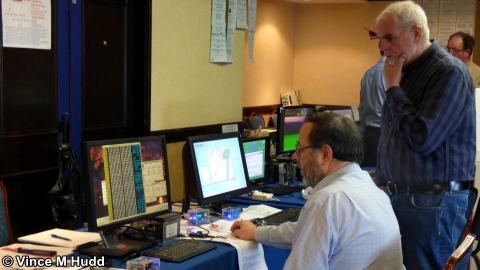
AMCOG Games
Tony Bartram added another title to the AMCOG Games catalogue for the Wakefield Show.

Island of the Undead is a first person shooter in which the player’s goal is to refuel a light aircraft in order to escape from an island chain. The only snag is the limited amount of fuel and therefore the range of the aeroplane, allowing little more than hopping from one island to the next.
Well, that and the small matter of a research team who in trying to extend life have unleashed a virus that reainimates the dead, turning them into flesh-hungry ghouls.
Oops.
The game was in the form of an early version at the show, with a little more work still to be done – but as always with Tony’s products, anyone who bought it at the show also received a code for !Store so that updates can be obtained free of charge. An update arrived about a month and a half later when the game was made available on !Store, with new features, bug fixes and improvements, and more maps to play.
Tony also had a theatre slot in which he began by explaining his reasons for developing on RISC OS and the approach he has taken for some of his software. This was followed by a demonstration of the new game, before looking at his Games Development Kit, and a couple of the other games.
CJE Micro’s / 4D
The little shop with a lot of stock, aka CJE Micro’s (and of course 4D) had the final stretch of tables on this side of the RISC OS Room, with both Chris Evans and Andrew Conroy present.

The pair had brought their growing range of computers with them, as well as a wide selection of software patches, peripheral hardware and upgrades, and the usual extensive range of components, etc.
Giving one of the show’s theatre talks, Chris explained that he has been a touch busy acting as project manager for the rennovation of his new house, so the business was largely being run by Andrew and Jason Jordon.
That aside, he went on to talk about some of the products currently available, such as a USB mouse with three buttons, and no scroll-wheel, the Small-y Mouse interface, the RaspberryRO-Lite, and the pressure sensitive graphics tablet.
He also brought up the Pi-topRO – CJE’s version of a laptop based around the Raspberry Pi. There is a newer version of the Pi-top, but as yet not a RISC OS version of it, because the information needed to allow CJE’s support software to be updated to match the changed hardware hadn’t been released.
Steve Fryatt

The next stand saw Steve Fryatt demonstrating his various items of software, including the latest version of grumpy home accounts package CashBook, PDF production package PrintPDF, and much more.
Steve was, as usual, selling a CD containing all of his software for a fiver, with proceeds going to the charity supported by the Wakefield group – of which Steve is a member.
When talking with Steve I made an observation that he had an application launcher running that I wasn’t familiar with, so he showed me it in a little more detail.
The launcher is called, er, Launcher and is one that Steve wrote himself, with the version running dating back to 2012. It’s not amongst the software currently available, but with a little tidying up Steve thinks it possibly could be – though that would be dependant on that much fabled resource called time, something many of us struggle to find.
RISC OS Open
ROOL corner was next, where Ben Avison and Rob Sprowson were present on behalf of RISC OS Open ltd (ROOL) to tell visitors all about the latest developments in the operating system itself, and anything directly related.
Version 5.24 of RISC OS was now available for all platforms except iMX6 and OMAP5. This could be bought from the stand, for example on micro-SD cards suitable for the Raspberry Pi – and for the same platform an updated version of the ePic card was available, a bootable micro-SD card for the Pi containing the OS and a wealth of additional commercial software.

The company was represented in the show theatre by Rob, with a talk covering what has happened in the year since the last Wakefield Show, the release of RISC OS 5.24 and the corresponding update to ePic, a new version of the user guide, stretching to over 600 pages, and more.
The talk led into what ROOL’s plans are for the future – the goals of some of the bounties, such as incorporating changes in the NetBSD USB stack in the RISC OS stack for instance.
And it finished with another reference to that April Fool in the form of a question. Oops again! (He writes, definitely without a grin!)
Drag ‘n Drop
For those who wanted a little light reading, Christopher Dewhurst – editor of on-off-on-off-under-new-management PDF magazine Drag ‘n Drop – had the next stand, where he was selling the usual flash drives containing the complete back catalogue of the magazine, along with some physical books, The Book of Draw Stuff, and 20th Century Fonts.

Soft Rock Software
Moving onto my own stand, I had the usual pair of machines running various old games – which form part of the Soft Rock Software Collection, available to buy on CD or USB flash drive.
The collection also includes software such as WebChange, Seek’n’Link, WaitUntil, and so on.
Also available were a diminishing stock of RiscPiC-mini cases – cases for the Raspberry Pi designed in homage to the iconic RiscPC.
Archive Magazine
The latest copy of Lesser Seen Archive magazine – issue 24.4 – hit subscribers’ doorsteps a few days earlier, just in time to include a preview of the show. Other features included reports on the Southwest and Recursion shows that took place a couple of months earlier, as well as the usual mix of news and features.

Editor Jim Nagel was, of course, taking subscription renewals and advance orders for an updated version of the CD/DVD, which will include digital versions of every edition of the magazine up to and including its 23rd volume.
Orpheus Internet
The penultimate stand was home to Richard Brown, representing both Orpheus Internet and RISC OS Developments Ltd.

Wearing his Orpheus hat, he was telling visitors all about the company’s new cloud solutions, as well as the usual internet connectivity packages. And wearing his RISC OS Developments hat, people could ask what the latest news was about the company, its funding, and its plans.
Of course, there was something big that happened later in the year – but that hadn’t happened at the time of Wakefield!
R-Comp
In the few days before the show, R-Comp‘s Andrew Rawnsley decided to tease the RISC OS community with talk of something small that would be shown off at Wakefield.
That turned out to me the mini.m, which amounts to a ‘mini’ version of the MSX ARMX6; it’s based around the same quad-core Freescale i.MX6 processor as the bigger machine, but comes in a cube-shaped case that’s aproximately two inches across in each dimension.
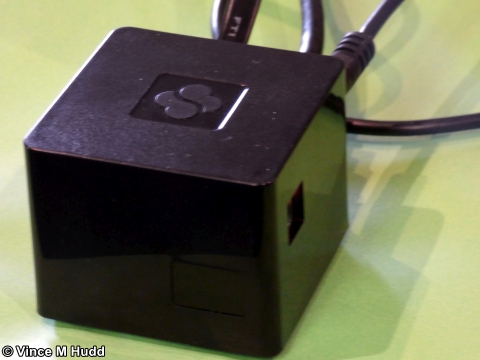
Software releases from R-Comp timed for the show included SafeStore 3 – a new version of the company’s backup software – although that wasn’t quite ready yet, and was being made available from that point on an ‘early access’ basis.
Messenger Pro 8 was released at the show, which brought with it significant security improvements in line with NetFetch 5, which was launched at Wakefield 2017 (and has seen more improvements since then). It also gains many other improvements over previous versions, such as better handling of HTML email and much more.
Some old games had also seen updates, with new versions of Wolfenstein 3D and the Doom Trilogy having been released about a week earlier.
Andrew was another of the show’s speakers – not the last in order at the show, but the last one in the order presented here.
In that talk, he covered all of the above and more besides – the status of PiFi version 3, for example, as well as showing off the new mini.m computer.
So that was the 2018 Wakefield Show. As ever, it was an enjoyable day, with plenty to see and do.
With this report coming after the London Show, the next main event on the RISC OS Calender is the Southwest Show, which will take place on Saturday, 16th February, 2019, at a new venue, the Arnos Manor Hotel in Bristol – which should hopefully be much easier for people to get to – so I hope to see lots of you there.
And after that, Wakefield 2019 will take place again at the Cedar Court Hotel on Saturday, 27th April, 2019 – and I hope to see you there, as well!
Meanwhile, here are some more pictures from this year’s show:
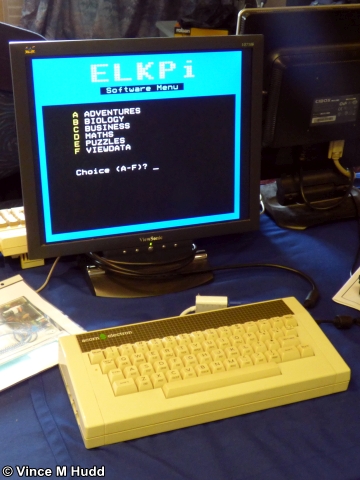



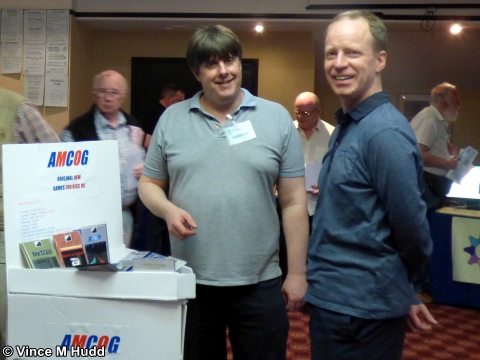






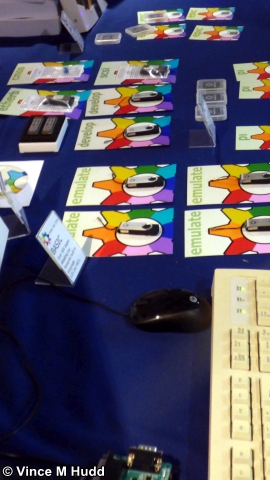
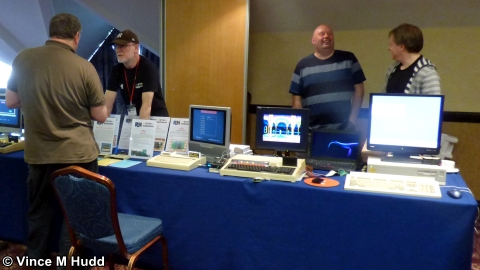

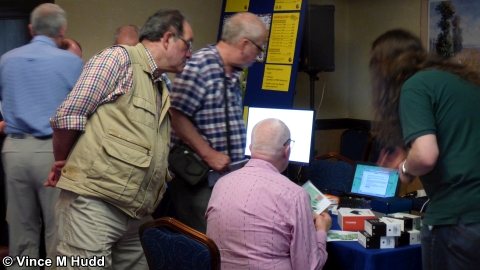


And finally, a question:




